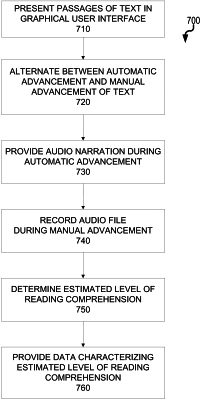| CPC G09B 17/003 (2013.01) [G06F 3/0483 (2013.01); G06F 15/0291 (2013.01); G06N 3/08 (2013.01)] | 18 Claims |

|
1. A method of assessing reading comprehension of a user, the method being implemented by one or more data processors and comprising:
presenting, in a graphical user interface, sequential reading text comprising a plurality of passages;
automatically alternating, while sequentially advancing through the plurality of passages and without user-input, between (i) a first state comprising automatically advancing through passages of the reading text and (ii) a second state comprising manually advancing through passages of the reading text within the graphical user interface, the manual advancing being in response to user-generated input received via the graphical user interface;
providing, during the first state, an audio narration of the corresponding passages;
recording, during the second state, an audio file;
periodically displaying, in the graphical user interface, comprehension questions in between the alternating between the first state and the second state;
receiving, by way of user-generated input received via the graphical user interface, answers to the comprehension questions;
automatically determining, based at least in part on the recording and the received answers, an estimated level of reading comprehension of the user, wherein the estimated level of reading comprehension is generated by a machine learning model, the output of which, indicating an ability of the user to understand meaning in the reading text, the machine learning model being trained using data derived from a population of readers when reading the sequential reading text including observed behavior in terms of response time and correctness of responses to comprehension questions; and
providing data characterizing the determined estimated level of reading comprehension of the user.
|